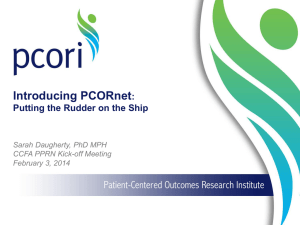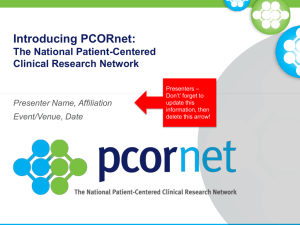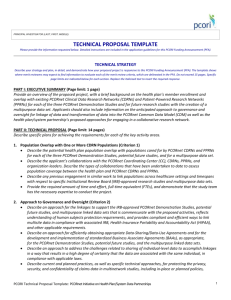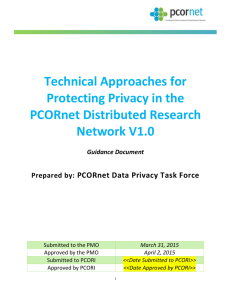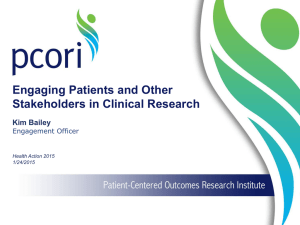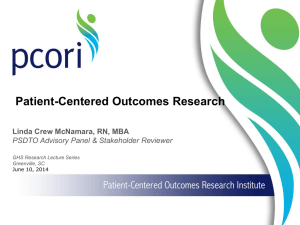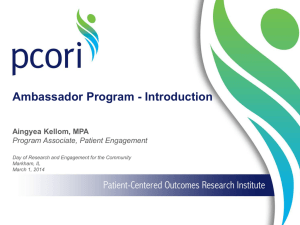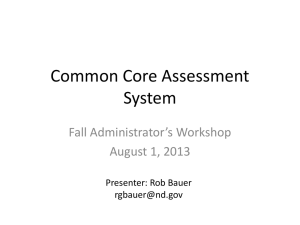Research Update - Bipolar
advertisement
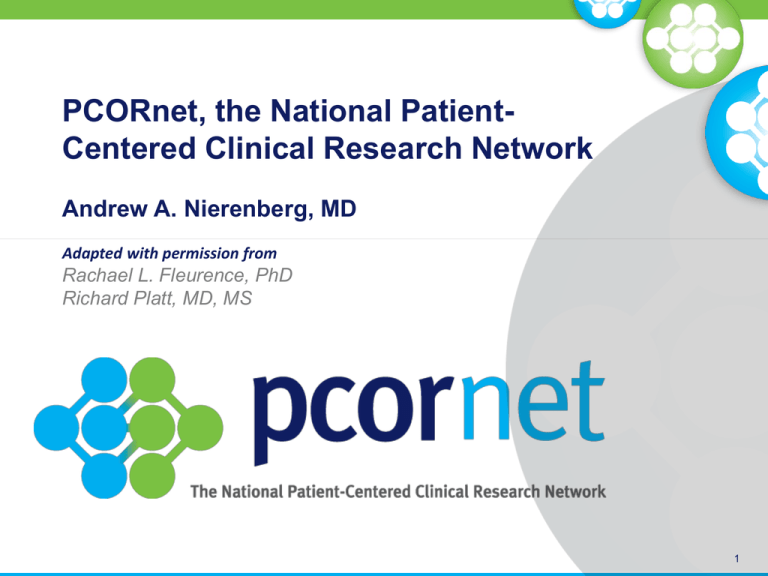
PCORnet, the National PatientCentered Clinical Research Network Andrew A. Nierenberg, MD Adapted with permission from Rachael L. Fleurence, PhD Richard Platt, MD, MS 1 PCORnet: the National Patient-Centered Clinical Research Network Goals: • Improve nation’s capacity to conduct comparative effectiveness research • Create large, highly representative, national patient-centered clinical research network • Conduct clinical outcomes research. 2 PCORnet: the National Patient-Centered Clinical Research Network Vision • Support a learning US healthcare system • Allow for large-scale research to be conducted with enhanced accuracy and efficiency. 3 What’s the problem? Clinical progress too slow Randomized efficacy trials Mean 5.5 years Mean > 7 years if grant submissions included Evidence implemented 14% 17 years Lags behind technological progress Riley et al. Clinical and Translational Medicine 2013, 2:10 Our Clinical Research System is Not Generating the Evidence we Need to Support Practice! High % of decisions not supported by evidence Poor health status of US population Great disparities Questions about reliability of the system growing Current clinical research system is great except: Too slow Too expensive Unreliable Doesn’t answer the questions important to patients Unattractive to providers and administrators in the system What’s a solution? Learning healthcare system Iterative feedback Clinicians Patients Administration Observation of outcomes EMR Randomization to reduce bias Learning health care systems PCORnet PCORI Patient Centered Outcomes Research Institute ACA act Tax on insurance companies Evolving PCORnet Network of networks Infrastructure for comparative effectiveness Goal 100 million patients Patient-centeredness: heart of PCORI’s mission and vision The Patient-Centered Outcomes Research Institute (PCORI) is an independent, non-profit health research organization authorized by the Patient Protection and Affordable Care Act of 2010. PCORI funds patient-centered research to assist patients, caregivers, and other stakeholders in making informed health decisions. Mission PCORI helps people make informed healthcare decisions and improves healthcare delivery and outcomes by producing and promoting high integrity, evidence-based information that comes from research guided by patients, caregivers, and the broader healthcare community. Vision Patients and the public have the information they need to make decisions that reflect their desired health outcomes. 9 Patients and stakeholders play critical roles in all aspects of PCORI’s work 10 Overall objectives of PCORnet: achieving a single functional research network Engagement of patients, providers and health system leaders Support and conduct of multi-center observational and interventional CER studies External data and research partners participate with PCORI-funded networks Researchers not directly affiliated with PCORnet participate through collaborative arrangements. PCORnet partners use the resources created with PCORI’s support for a range of activities supported by other organizations. 11 29 CDRN and PPRN awards were approved on December 17th by PCORI’s Board of Governors 13 Clinical Data Research Network Partners 14 Goals for Clinical Data Research Networks (CDRNs) Extracts from EHR data are standardized within PCORnet A minimum of 1 million patients enrolled Capable of implementing clinical trials Individual network’s data in interoperable format with other awardee networks and successfully responds to queries Patients, health system leaders, and clinicians involved in governance and use of network At least three patient cohorts identified, characterized, and surveyed 15 CDRN Highlights • Networks of academic medical centers, hospitals and physician practices • Networks of non-profit integrated health systems • Networks of low income clinics • Networks leveraging AHRQ investments and NIH investments (CTSAs) • Inclusion of Health Information Exchanges • Wide geographical spread • Inclusion of underserved populations • Range from 1M covered lives to 28M 16 11 CDRNs CDRN Name Lead Organization Principal Investigator ADVANCE Oregon Community Health Information Network Jennifer DeVoe CAPriCORN The Chicago Community Trust Terry Mazany Great Plains Collaborative University of Kansas Medical Center Lemuel Waitman Louisiana Clinical Data Research Network Louisiana Public Health Institute Anjum Khurshid Mid-South CDRN Vanderbilt University Russell Rothman NYC-CDRN Weill Medical College of Cornell University Rainu Kaushal PEDSNet The Children’s Hospital of Philadelphia Christopher Forrest PORTAL Kaiser Foundation Research Institute Elizabeth McGlynn pSCANNER University of California, San Diego Lucila Ohno-Machado P2ATH University of Pittsburgh Rachel Hess SCIHLS Harvard University Kenneth Mandl 17 Harvard SCIHLS Harvard affiliated hospitals plus IT infrastructure I2B2/SHRINE/SmartApps Websites Feedback to individual patients Aggregate information to curious minds (Similar to Patients Like Me) CDRNs Disease Cohorts Organization Common Cohort Rare Cohort ADVANCE Diabetes Co-infection with HIV and hepatitis C virus CAPriCORN Anemia; Asthma Sickle cell disease; Recurrent C. Difficile colitis Great Plains Collaborative Breast Cancer Amyotrophic Lateral Sclerosis (ALS) Louisiana Clinical Data Research Network Diabetes Sickle Cell Disease, Rare Cancers NYC-CDRN Diabetes Cystic fibrosis Mid-South CDRN Coronary Heart Disease (CHD) Sickle Cell Disease (SCD) PEDSNet Inflammatory bowel disease Hypoplastic left heart syndrome PORTAL Colorectal Cancer Severe Congenital Heart Disease pSCANNER Congestive Heart Failure Kawasaki Disease P2ATH Atrial Fibrillation Idiopathic Pulmonary Fibrosis SCIHLS Osteoarthritis Pulmonary arterial hypertension 19 Patient Powered Research Network Partners 20 Goals for Patient Powered Research Networks (PPRNs) Target size of 0.5% of U.S population with condition: (> 50 patients for rarest diseases; 50,000 for most common) Patient-reported data collected for at least 80% of cohort Patients involved in governance Standardized data suitable for sharing with other infrastructure members and successfully responds to queries 21 PPRN Highlights • Variety of stakeholders in participating organizations and in leadership team: patients, advocacy groups, physician organizations, academic centers, PBRNs etc. • Strong understanding of patient engagement • Significant range of conditions and diseases • Variety in populations represented (including pediatrics, underserved populations etc.) • 50% rare diseases • Significant range in the maturity of the group in terms of data available • Several have capacity to work with biospecimens 22 9 PPRNs in “non rare” conditions Organization Multiple Sclerosis Proposed PPRN Population Size 20,000 American Sleep Apnea Association Susan Redline Sleep Apnea 50,000 Cincinnati Children's Hospital Medical Center Peter Margolis Pediatric Crohn's Disease and Ulcerative Colitis 15,000 COPD Foundation Richard Mularski Chronic Obstructive Pulmonary Disease 50,000 Accelerated Cure Project for Multiple Sclerosis PI Robert McBurney Condition Crohn’s and Colitis Foundation of R. Balfour Sartor America Inflammatory Bowel Disease (Crohn’s disease and 30,000 ulcerative colitis) Global Healthy Living Foundation Seth Ginsberg Arthritis (rheumatoid arthritis, spondyloarthritis), 50,000 musculoskeletal disorders (osteoporosis), and inflammatory conditions (psoriasis) Massachusetts General Andrew Hospital Nierenberg Major Depressive Disorder (MDD) 50,000 and Bipolar Disorder (BP) Univ of California, San Francisco Mark Pletcher Cardiovascular health 100,000 University of South Florida Rebecca Sutphen Hereditary Breast and Ovarian Cancer (HBOC) 17,000 23 9 PPRNs in rare conditions Organization PI Condition Proposed PPRN Population Size ALD Connect, Florian Inc Eichler Adrenoleukodystrophy 3,000 Arbor Research Collaborative for Health Bruce Robinson Primary Nephrotic Syndrome (Focal Segmental Glomerulosclerosis [FSGS], Minimal Change Disease [MCD], and Membranous Nephropathy [MN] Multiple Sclerosis 1,250 Duke University Laura Schanberg Juvenile Rheumatic Disease 9,000 Epilepsy Foundation Janice Beulow Aicardi Syndrome, Lennox-Gastaut Syndrome, Phelan-McDermid Syndrome, Hypothalamic Hamartoma, Dravet Syndrome, and Tuberous Sclerosis 1,500 Genetic Alliance, Inc Sharon Terry Alström syndrome , Dyskeratosis congenital, Gaucher disease, Hepatitis, Inflammatory breast cancer, Joubert syndrome, Klinefelter syndrome and associated conditions, Metachromatic leukodystrophy, Pseudoxanthoma elasticum (PXE), Psoriasis Immune Deficiency Foundation Kathleen Sullivan Primary Immunodeficiency Diseases 1,250 Parent Project Muscular Dystrophy Holly Peay Duchenne and Becker muscular dystrophy 4,000 Phelan-McDermid Syndrome Foundation Megan O’Boyle Phelan-McDermid Syndrome 737 University of Peter Merkel Vasculitis 500 50- 50,000 24 Mood PPRN Depression or Bipolar Patient-collaborators/citizen-scientists Advocacy Groups DBSA NAMI International Bipolar Foundation Anxiety Depression Association of America Goal: 50,000 patient-collaborators nationwide Strategy: Multipronged EMR and clinicians Internet and social media 25 Mood PPRN Unprecedented opportunity Patients as partners Reshape research Compare treatments Collectively improve outcomes Collectively discover benefits and risks Collectively explore biology • Biospecimens • Genes • Biomarkers Built on Trust Board of Governors Meeting, 26 Overall objectives of PCORnet: achieving a single functional research network Engagement of patients, providers and health system leaders Support and conduct of multi-center observational and interventional CER studies External data and research partners participate with PCORI-funded networks Researchers not directly affiliated with PCORnet participate through collaborative arrangements. PCORnet partners use the resources created with PCORI’s support for a range of activities supported by other organizations. 27 Task Forces 28 Governance & Collaboration Task Force Leads: Rich Platt, Erin Holve, CDRN/PPRN co-lead TBD Goal/Purpose: Develop policies that support trust and collaboration 29 Overall objectives of PCORnet: achieving a single functional research network Engagement of patients, providers and health system leaders Support and conduct of multi-center observational and interventional CER studies External data and research partners participate with PCORI-funded networks Researchers not directly affiliated with PCORnet participate through collaborative arrangements. PCORnet partners use the resources created with PCORI’s support for a range of activities supported by other organizations. 30 Data Privacy Task Force Lead: Deven McGraw, CDRN/PPRN co-lead TBD Goal/Purpose: • Identify privacy issues raising particular challenges • Highlight promising or best practices for addressing them • Develop privacy policies to govern data sharing 31 Patient & Consumer Engagement Task Force Lead: Sean Tunis, Pat Deverka, CDRN/PPRN co-lead TBD Goal/Purpose: • Ensure engagement of patients and consumers in all components of PCORnet • Serve as technical resource, with PCORI staff 32 Health Systems Interactions Task Force Leads: Eric Larson, Katherine Newton, CDRN/PPRN co-lead TBD Goal/Purpose: Help the CDRNs create a supportive environment for clinical research with their clinicians and clinical leadership 33 Ethics and Regulatory Task Force Leads: Jeremy Sugarman, Joseph Ali, Rob Califf, CDRN/PPRN co-lead TBD Goal/Purpose: Address ethical and regulatory issues related to research that arise in PCORnet’s work 34 Patient-Reported Outcomes Task Force Lead: Amy Abernethy, CDRN/PPRN co-lead TBD Goal/Purpose: Focus on measurement, collection, and analysis of patient-generated information 35 Clinical Trials Task Force Lead: Rob Califf, CDRN/PPRN co-lead TBD Goal/Purpose: • Adopt methods, standards, and quality by design principles for clinical trials • Develop pathways for trials, oversee trial conduct, feed back learnings 36 Rare Diseases Task Force Leads: Priya Kishnani, Rachel Richesson, CDRN/PPRN co-lead TBD Goal/Purpose: • Support identification of populations and research priorities for studies of rare diseases • Create an information source for rare diseases research • Create a discussion and advocacy forum to identify and advocate for needs specific to rare diseases research 37 Biorepositories Task Force Lead: Kristin Newby, CDRN/PPRN co-lead TBD Goal/Purpose: Support a regulatory-compliant, comprehensive, and sustainable Network-wide biorepository to serve PCORnet research 38 Obesity Task Force Lead: Matthew Gillman, CDRN/PPRN co-lead TBD Goal/Purpose: Facilitate construction of the obesity cohort at each CDRN, and identify potential research uses 39 Some takeaways We need a new national capability for efficient, large-scale interventional and observational patient centered research PCORnet will need to: Establish priorities that clinicians, clinical leaders, patients, and investigators share Facilitate trust leading to collaboration between networks Embed research into practice settings without disrupting clinical operations Create a distributed data network that protects patients’ confidential information Develop oversight procedures that protect patients while minimizing redundancy Engage individuals and organizations beyond the initial awardees 40 Mood PPRN Become a member www.moodnetwork.org Will go live by Oct 1, 2014 Board of Governors Meeting, 41 42
